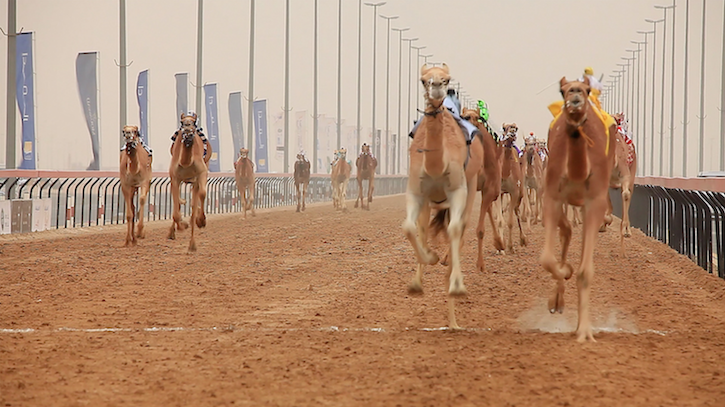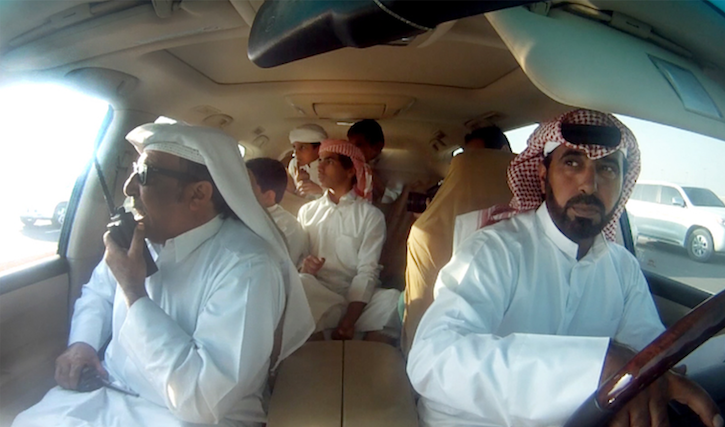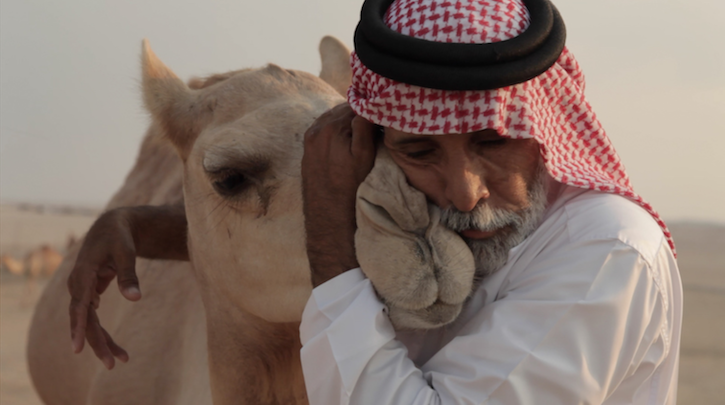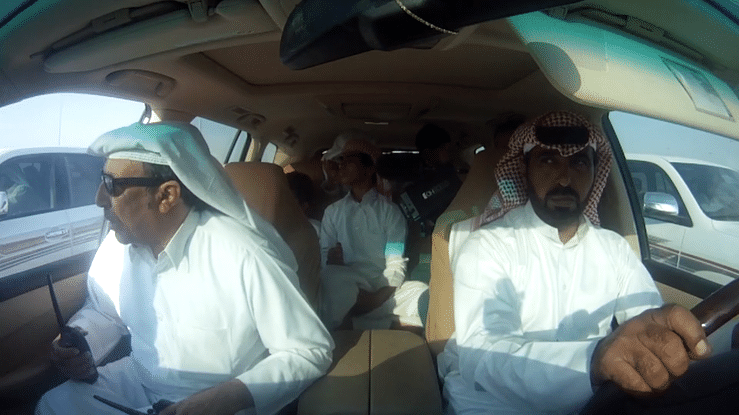A Story on Story: Camel Races, Robot Jockeys, and Filmmaking
Isabelle Carbonell
When I first heard there were camel races, I had a hard time believing they existed, never mind that they raced with robot jockeys. For a few years, I had been working in Doha, Qatar, where gleaming skyscrapers and malls dominate the landscape. One day, I was told to go to a spot an hour away, at dawn, and not to be late. There, I witnessed a scene I would see many times again: camels racing, soft padded feet making no sound, gangly legs gracefully overreaching their bodies, white froth dripping from their big lips, while cars rode alongside to control the robot jockey’s whip. The sport embodies Qatar’s modern Bedouin heritage, and I immediately thought: this is it. This is the film I’d been searching to make about Qatar. At this point in my career, I was also trying to establish myself as a documentary filmmaker and I came up against the problem of story again and again. More precisely, I found problematic the single-character narrative arc, also known as the “hero’s journey,” or the three-act structure, which the documentary film market has imposed as a condition for the production of a successful commodity. This type of story structure, espoused in fiction, is very difficult to adopt in documentary. Indeed, during the making of the first version of my film The Camel Race, I learned first-hand the high costs—personal, creative, and professional—of choosing this narrative structure.
 Figure 1. The finish line of a high-stakes camel race. Dubai, UAE, THE CAMEL RACE (Carbonell, 2019).
Figure 1. The finish line of a high-stakes camel race. Dubai, UAE, THE CAMEL RACE (Carbonell, 2019).
If a film does not center around a human being, on some kind of quest (physical, intellectual, emotional, spiritual, etc.) or undergoing some monumental life change full of conflict, it tends not to be considered worthy as a subject of documentary. Once, after explaining my film as a set of vignettes on both humans and nonhumans telling the story of a chemical tragedy, a producer asked me: “Yeah, but what’s the story? The real story.” When I asked him what he meant, he replied, “Well, like, who is the hero who’s going to lead us through this landscape, who has like, cancer he’s dying from, or something? You know, some Erin Brokovich shit.” Or, in the words of another TV producer who watched a portion of my very first film, Trashborn, which is a portrait of seven different trash-divers in a garbage dump in the Dominican Republic: “No main character? No eyeballs. No dough. Find a better story.” I ran into similarly dispiriting reactions during many pitch forums for other film ideas I had. In the third edition of the textbook Documentary Storytelling: Creative Nonfiction on Screen, there is a chapter centered around structure which uses the metaphor of a “train” to describe how one should think of story structure. One should “get on a train” and not get off until the end, though we may see things in passing out the window or take detours; the idea being that the plot has to stay in linear momentum through a defined beginning, middle, and end. Of the chapter’s twenty pages, seventeen are dedicated to lengthy discussions about how to fit a documentary film into a three-act structure despite its “Hollywood origins,” while subheaders explain the “inciting incident” and “point of attack.”{1} A brief acknowledgement at the end admits that not all films will fit in this structure, and in a section called “Other Structures,” spanning just a few pages, general pointers are given for non-three-act structures. In case there were any doubts after this brief detour, the next chapter, “Time on Screen,” gets back on the train, as it were: “Film is a linear medium. People watch it from beginning to end . . . ‘I’ve never seen an even vaguely successful documentary film that does not move forward through time,’ says filmmaker Jon Else.”{2}
The premium placed on this type of story structure stood in the way of grants, pitching forums, festivals, and television commissions. I knew that if I wanted work in this field, I needed to radically alter my approach. If I could just find the perfect story, the perfect real-life character, which I could somehow film at the exact time they were undergoing some huge change in their lives, with a lot of juicy conflict, I could unlock it all. Unfortunately, a lot of the films I was interested in making didn’t fit this formula. I tend towards durational filmmaking, often about the relationships between people and the land, or the interconnections between species, or about the history of a particular site. I was as much interested in communities and landscapes and animals and microbes and ecosystems, not just in individuals and their heroic journeys. Having gatekeepers tell me over and over again to change my approach to fit this extremely narrow and limiting formula deeply affected my way of thinking. This turmoil around narrative structure culminated in The Camel Race.
Camel racing is an invented tradition. In the 1960s, explorations for natural gas in the Persian Gulf resulted in an unprecedented oil boom. Qatar became the third largest producer of the stuff in the world. Overnight, it metamorphosed from a sleepy Bedouin country to a cosmopolitan oasis pocked with Venetian canals. Qataris moved from tents into modest concrete houses then moved again into luxury villas. Camels were traded for cars: the people’s previous dependence on the animal for transportation, clothes, fur, milk, meat, and companionship vanished. Camels wasted away, abandoned, until the Emir had a brilliant idea, inspired by horse racing: camel races with hefty prizes, to reinvigorate interest in Qatar’s heritage.
Dusting off their camels, Qatari owners quickly figured out that the lighter the jockey, the faster the camel, the better one could win a race. Children began to race. Then the prizes became so lucrative that an immigrant child slave trade began, where young Bangladeshi children were brought over to ride instead of Qatari children, and given hormones to stop growing so they could stay light. Many died falling off camels or from malnutrition. This criminal exploitation continued for decades until an international outcry imposed a moratorium on child jockeys in 2005. Camel racing was declared dead. Until robots appeared.
Fast forward: I pitched the film to a TV channel using the classic single-character narrative arc. I did this in part because I knew this was the only way to get the commissioning grant. Having had so many rejections at this point, I went with the winning formula, thinking I would structure my other films differently in the future. I proposed that we’d follow a camel owner during a part of the racing season, which included a race with particularly high stakes. Not trusting myself to make a single-character narrative film, I decided to bring on a Lebanese-American male co-director who had been a professional video journalist for the Washington Post.
We then set on a two-month filming adventure, trying to gather material that would fit into the single-character narrative mold. For a protagonist, my co-director and I decided on Ali, who had up-and-coming camels who were meant to be getting “better and better” with every race. A few weeks in, after Ali lost race after race, we realized that we were going to have to expand our focus, because “nothing was happening.” We found a foil, a much richer baron named Abaid who actually won many of his races. We thought, great, here’s our story: loser versus winner. Soon after, Ali said he would reveal a secret to us. He pulled syringes out of a fridge and led us to his camels. This is when we learned he had stopped giving steroids to his camels while we filmed, and that this is why he was losing. We learned that the entire camel racing community used steroids, and this was how Abaid was staying on top. Though the camels were treated like royalty off the racetracks, fed partly on a diet of sweet dates, they were driven extremely hard during the races. That steroids were involved pushed the already absurd camel-robot sport into a space of horror. Yet, apart from my dismay that the camels were doped, and that our presence had changed Ali’s practice so drastically, I was also full of glee: this was the twist, the reveal, our story needed.
 Figure 2. THE CAMEL RACE. Family members gather together to support the racer, Abaid, front left, during a
highly tense race with one of his top female camels. Qatar.
Figure 2. THE CAMEL RACE. Family members gather together to support the racer, Abaid, front left, during a
highly tense race with one of his top female camels. Qatar.
But the steroids weren’t enough. The more we filmed, the more we realized that these men would never let us into their lives in the way we needed: intense, intimate shooting access. Their wives, and by extension their families, were completely off-limits due to cultural mores. Furthermore, the daily lives of these men simply weren’t very active; they had servants do almost everything for them, including making tea and tending to the camels. This wasn’t immediately evident the first few times I had scoped out the scene. Most importantly, it was unclear what was at stake for them. Despite statements to the contrary, ultimately we saw that winning or losing a race did not alter their lives that much. Instead it was the strange ecosystem of the camel world, apart from the Qatari owners, that emerged as the focus. How and when did the steroid trade emerge? What were the long-term effects on the camels? Who made the robot jockeys? We also looked into the fact that immigrant laborers had no rights: one Bangladeshi camel worker had been there 25 years without a raise, and another worker’s thumb had been bitten by a camel, an injury for which he received no medical attention despite an infection.
In our research, we learned that the local laundry shops had a rating system for how bad the camel excrement stained thobes, the all-white Qatari national garment. We learned how racing camels, once finished with their career, were sometimes “retired” and turned into camel beauty pageant contestants. To win these competitions, the camels had to be slicked with oil, adorned with woven sequined head-dresses, and display fat, luscious hanging lips (for which botox was used). But none of these many interesting worlds cohered into one single character-driven three-part dramatic arc.
My co-director had produced Emmy-award winning short documentaries, often doing his own voiceover segments to provide structure. Though I learned a lot from watching a different approach in the field, ultimately I found that his journalistic training and style of shooting fell short for a feature-length film; his story instincts did not help us at this scale. We also had a lot of gender-related issues between us. Being fifteen years my senior, with some modest accolades, he took the lead quite forcefully instead of seeking a more cooperative balance.
In my dedicated pursuit of story, other problems arose. Creating a film that centers on a human being’s journey requires spending a lot of time in their presence, pointing a camera at them, in intimate spaces during all times of day. For some characters, the attention they receive is like a drug: as the filmmaker, I become an ideal companion, an infinitely patient, non-judgemental listener who takes interest in everything they do. If one adds, to this already difficult situation, tense gender relations in a culturally conservative country, the recipe becomes explosive.
The first time Ali invited me inside his car for a ride, I sensed his excitement: it was a thrill, forbidden even, to have an unaccompanied unmarried woman alone to himself. In lands where women are outnumbered seven to one, and cultural values are conservative, I was breaking a lot of conventions in making this film: the only woman around for miles in a totally male-dominated sport. Ali watched me closely. All the men watched me closely. I thought that if I kept my distance, everything would be fine. The problem was that the type of filmmaking we were engaging in, where one person ran both video and audio, and the type of story we were after, an intimate up-close character portrait, all serve to erase that distance.
Abaid, our foil to Ali, proposed to me, in jest, to be his fourth wife. Khaled, ex-jockey and radio announcer, cornered me in his home minutes after his wife and children left to show me his wife’s lingerie and try to kiss me. Mohammed took me out to his camel farm in the middle of the desert and on the way home after sunset, started touching different parts of my body to “teach me the names in Arabic” and then tried to get me to lie down on the bed of his truck to “watch the stars.” I got out of these situations relatively unscathed, though extremely troubled, but the real problem was our chosen main character, Ali. At first it was flirtatious behavior, such as comments on my physical appearance. Although I understood a lot of Arabic, I could not speak much and tried to leverage this as a wall between us. This helped a bit, but he found ways to communicate. One day, alone in the car with him while he was observing his camels being trained on the tracks, he told me a story about a woman he had slept with who loved his hairy chest. When we got back to the farm, I told my co-director I could no longer film Ali alone, and that I’d rather he take the lead on all things Ali. A week later, Ali noticed the change and had a tantrum. He declared he wouldn’t participate in the film unless I was the one shooting him instead of my co-director. He understood the power he had over us after we had already invested so much time and energy into developing his story. Regardless, we stopped filming Ali completely and tried to expand the scope of our film. With only two weeks left on our trip, it was a bit late. We had already wasted six weeks shooting Ali and Abaid in the quest of a hero’s journey through a camel race season.
 Figure 3. THE CAMEL RACE. While ‘Old Ali’ loved his camels and they loved him in return, it wasn’t a good idea
for me to film him alone at his camel farm. Qatar.
Figure 3. THE CAMEL RACE. While ‘Old Ali’ loved his camels and they loved him in return, it wasn’t a good idea
for me to film him alone at his camel farm. Qatar.
After we ended our two-month shoot, I flew home deeply disturbed but unable to name what had just happened. I had put story ahead of every creative instinct I had, and in front of my own safety. I had made story an emperor, and I became its slave.
My co-director and I tried to edit a film featuring Ali for years afterwards, but in the end, we predictably failed. Ali and Abaid could not provide a strong three-act structure; the steroids weren’t enough of a climax. We didn’t have enough footage to tell the story of the larger camel world either, and so we shuttered the deal with the channel and the experience left us both very frustrated. On my end, I knew I had to find a community different from the commercial documentary filmmaking world, which is what led me to re-enter academia. Eventually, being exposed to massively different styles of work, and in conversation with a robust intellectual community, I was able to salvage some footage and create a completely different film that is composed of only four long takes. I think this new twenty-six-minute film says more about camel racing than Ali’s storyline ever could. It demonstrates a race four times, from four vantage points, each “take” roughly between eight and eleven minutes long. One of the four shots features the entire eight kilometer race from the back of a camel. At about the six kilometer mark, the whip is deployed. The force of the whip nearly disintegrates the image. Foam from the camel’s mouth obscures a part of the screen. In its very durationality there is a sensorial experience that offers a type of visceral knowledge that would be impossible to convey through a single-character narrative arc. There is an unsettling triple embodiment: of camel, of robot, of human. It is the first time we begin to contrast the camel’s physical labor with the human’s physical labor.
Excerpt from THE CAMEL RACE, Isabelle Carbonell (2012/2019).
This new film is not perfect. It is not able to capture the entire ecosystem that we had discovered: the history of how the races started, of the child jockey abuse, of the steroids, of the slave-like system of immigrant labor, the relationships between the immigrant caretakers and the camels, or even the relationships between the camels themselves. What this new film does, however, is to make visible all the juxtapositions and contradictions that happen in the space of a race: the web of interrelationships between camel and robot, robot and human, camel and camel, human and car, camel and human.
Single-character narrative arcs offer only a very narrow, deeply anthropocentric understanding of the world. Documentary can do better. It is not to say that there is never a time or a place for such a format, but it shouldn’t be used to the exclusion of all other approaches for structuring a documentary. Non-Western narrative structures often differ from linear crisis-climax-resolution arcs. Donna Eder, for example, studied Navajo story structures and found that, “Instead of a linear structure in which the plot develops based on events that happen over time, a cyclical structure, which links events and actions that occur simultaneously, is more common in Navajo stories.”{3} Eder explains that Navajos eschew concepts like “beginning” and “ending”; instead stories are repeated, and themes recur, with no clear ending or final lesson or moral.{4} Sometimes stories feature segments which are repeated several times. Nicholas Cragoe analyzes the ways that indigenous narrative structures and stories can act as a decolonizing force against the settler-state.{5} Similarly, in an article calling for “counter-storytelling” methods for urban US school, Lewis Asimeng-Boahene argues that African proverbs, which are short, universal “narratives,” can provide a vehicle for teaching social justice.{6} In the field of documentary film, I have found the most creative alternative narrative structures in interactive documentaries, where multi-linear, sometimes nonhuman, polyvocal modalities have arisen in collective protest.{7}
My detox from the experience making the first version of The Camel Race was long and difficult, but shedding the constraints of this model has allowed my creative process to reemerge, invigorated with the possibilities of cinema for knowledge-making. Today, I make nonfiction films about the so-called Anthropocene, environmental disasters, and ecosystems in trouble: eco-systems, not individuals, and I explore the interconnections between human and more-than human lifeforms within the context of colonialism, chemical legacies, deep time, and speculative futures.
Single-character narratives are not the villain. Rather, the problem is the power that funders wield in the world of documentary. When making money becomes the only goal, then a film becomes strictly a commodity. Commodities need predictable formulas. Documentaries, however, deal with unscripted life, the anti-formula. Single-character narrative arcs suit some situations, but not all. And most often, focusing on a single character forecloses the potential for broader systemic evaluation, which reinforces the capitalist logic that there’s no such thing as a commons, only individuals and their stories.{8}
How can collective, multi-linear, and spatial approaches to documentary media-making provide experiences of relationality and offer alternatives to the narrowness of single-character exceptionalism and anthropocentrism? And while I embrace the movement to go beyond story, I also call upon Donna Haraway’s mantra to stay with the trouble. Perhaps the ultimate question facing my own practice, and us all is: how can documentary reclaim story?
Title Video: The Camel Race, Isabelle Carbonell (2012/2019).
{1} Sheila Curran Bernard, Documentary Storytelling: Creative Nonfiction on Screen, 3rd edition (Amsterdam: Focal Press, 2010), 55.
{2} Ibid, 67.
{3} Donna Eder, “Bringing Navajo Storytelling Practices into Schools: The Importance of Maintaining Cultural Integrity,” Anthropology & Education Quarterly 38 (August 1, 2007): 281.
{4} Ibid, 286.
{5} Nicholas G. Cragoe, “Narrating Indigenous Boundaries: Postcolonial and Decolonial Storytelling in Northern Minnesota,” Nationalism and Ethnic Politics 23, no. 2 (April 3, 2017): 182–202.
{6} Lewis Asimeng-Boahene, “Counter-Storytelling with African Proverbs: A Vehicle for Teaching Social Justice and Global Understanding in Urban, U.S. Schools,” Equity & Excellence in Education 43, no. 4 (November 11, 2010): 434–45.
{7} Patricia R. Zimmermann and Helen De Michiel, Open Space New Media Documentary: A Toolkit for Theory and Practice (New York: Routledge, 2017).
{8} See articles in this volume by Paige Sarlin and Brett Story.



